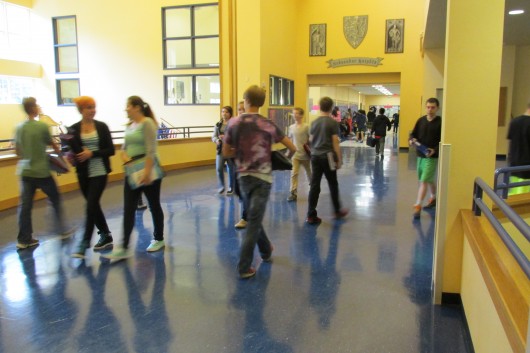Ketchikan has an “it won’t happen here” attitude that contributes to some lax safety standards at local schools. That is one of the findings in a draft safety assessment of the Ketchikan School District from an outside non-profit.
The Ketchikan School District earlier this year commissioned a $29,000 safety assessment from Safe Havens International. The Georgia-based non-profit analyzes school security around the country.
Safe Havens visited each Ketchikan public school last spring. They also interviewed staff and reviewed emergency procedures. The report outlines strengths, weaknesses and recommended improvements.
Ketchikan Superintendent Robert Boyle says high-profile incidents such as the mass shooting at Sandy Hook Elementary School in Newtown, Conn. prompted the school district to seek out this assessment.
“We wanted to get an analysis here to make sure we’re doing everything that’s possible,” Boyle said. “There’s no imminent fear, no specific issue other than we see it as our priority to take care of the children who are our students.”
The Safe Havens report begins with positive observations, including these: The staff interacted in a positive manner with students, and the working relationship with the school district and public safety agencies is “excellent.” Safe Havens also commended the school resource officer program – which stations a police officer at Ketchikan High School.
Then we get into the opportunities for improvement. Safe Havens says the relatively low crime rate in Ketchikan results in an “it won’t happen here” attitude.
“I thought that was a good attention-getting reflection from somebody who’s not in Ketchikan,” Boyle said. “Meaning that, you know, it can happen in any community and it’s something for us to sit down and think about purposely on whether we want to adopt these measures or not.”
The report says that the attitude persists even though there have been three “gun incidents” involving Ketchikan students since 1989.
Safe Havens was critical of lax visitor access at many of the schools. The report said some members of the community have been resistant to efforts to tighten control of visitor access.
All of the schools have gaps in their visitor screening processes, the assessment says. The Safe Havens analysts were asked to show their IDs at only two schools. The report says allowing visitors to check themselves in is a “dangerously ineffective approach.” The schools do not have a way of checking visitors against people who are banned from the campus or who have outstanding court orders or are register sex offenders.
The report says the charter schools at Valley Park appear to be at a higher level of risk because of the building’s open design and multiple entrances.
Other areas of improvement: Safe Havens observed students wandering the hallways unsupervised at one-third of the schools. Staff at all of the schools didn’t consistently wear photo identification. At two-thirds of the schools, there were unlocked or unsecured entrances. Some classrooms had door windows covered in a way that creates “inappropriate levels of privacy.”
The report also recommends updating current codes of conduct and emergency plans. It found that the current crisis plan is cumbersome and overwhelming for school employees to learn. It was developed 14 years ago.
Safe Havens tested some staff members in crisis simulations, and there was a high fail rate. The report recommends revising plans and focusing on empowering staff to implement life-saving protective actions.
Safe Havens recommends the school district put a mental health recovery plan and a family reunification plan in place in the case of a mass casualty event. It is also critical of Ketchikan’s reliance on life-flight jets for any mass casualty event.
There are dozens of improvements recommended in the report. It’s a lot to process, but Boyle says he’s grateful for the third-party perspective.
“We’re really glad to have this report,” Boyle said. “We see it as very critical in some aspects but that’s why we’re doing it. This is not something we can be lax on.”
What will the district do with all the recommendations? Boyle says he is meeting with school principals to talk about it. The Ketchikan School Board also will weigh during tonight’s meeting at 6 p.m. in the White Cliff building.
The School District has posted the safety assessment draft on its website. According to Safe Havens Executive Director Michael Dorn, their group gives a draft assessment to the school district and waits for feedback from administration before finalizing the report.






